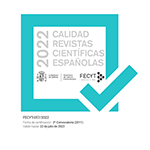Quantitative ethnobotanical investigation of medicinal plants used by local population in the rural municipalities of Haizer and El Asnam, province of Bouira, Northern Algeria
Abstract
This study aims to assess ethnobotanical knowledge in Kabylia, focusing on the traditional uses of medicinal plants. The purpose was to quantify the traditional knowledge of medicinal plants commonly used by local populations for treating a wide range of ailments, with a view to preserve the medicinal knowledge and the biodiversity of this area.
Ethnobotanical data was gathered using a questionnaire. Semi-structured interviews were conducted with 69 key informants at six villages of Bouira province. A quantitative analysis by means of different indices including the informant consensus factor (FIC), use value (UV), relative frequencies of citation (RFC), and fidelity level (FL), was performed for the recorded medicinal plants.
Overall, 136 plants species were recorded. Their uses in 10 disease categories were documented. They belong to 54 families, the most represented are the Asteraceae (18 species) and Lamiaceae (16 species). With 98 use reports, diabetes is the most treated ailment. The highest RFC values are recorded for Carthamus caeruleus (0.57) and Asplenium ceterach (0.52), indicating that these plants are the most preferred species used in study areas, to treat skin burns and kidney stones respectively. Plant with the highest use value is Lavandula stoechas (1.21), used to treat different digestive disorders (bloating, colon pain, and stomach ulcer). We found 13 medicinal plants having the highest FL value (100%), e.g. Rhamnus alaternus (jaundice), Lonicera implexa (weak eyesight), and Ulmus minor for treating skeletomuscular ailments. These latter are the most interesting species used in the treatment of a specific ailment category. The maximum FIC value (0.86) indicated that there was high agreement in the use of plants (e.g. Aristolochia fontanesii and Ophrys speculum) in genitourinary and reproductive ailment category among the informants.
We highlighted the homogeneity of informant knowledge in medicinal plants appropriate for different ailment categories and the most preferred plant species used to treat each ailment category in the study area. By overstepping the limits of an orally transmitted pharmacopoeia, we aim to valorize the huge ethnopharmacology legacy of the region for promising pharmacological perspectives.
Downloads
Article download
License
Mediterranean Botany is an open access journal to promote global exchange knowledge. It facilitates unrestricted access to its contents from the moment of publication in its electronic edition. The originals published are property of the Universidad Complutense and it is mandatory to cite such source in case of total or partial reproduction. All contents are distributed under a Creative Commons License 4.0 (CC BY 4.0). This circumstance must be expressly stated in this way when necessary. You can check the informative version and legal text of the license.














